Posts Tagged: vegetable
Larry Godfrey: 1956-2017, Friend of Alfalfa, Rice and Other Crops
UC Cooperative Extension entomologist Larry Godfrey, a 26-year member of the UC Davis Department of Entomology and Nematology faculty and widely...
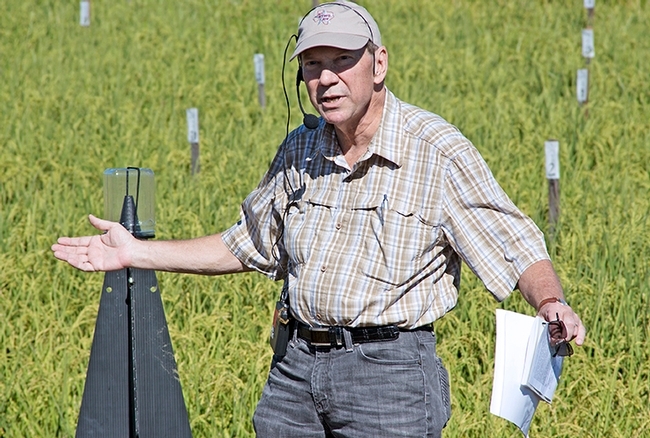
Extension entomologist Larry Godfrey presenting a talk at the 2016 California Rice Field Day in Biggs. He spoke at the annual field day for 25 years. (Photo by Evett Kilmartin, UC ANR)
Tomato Trivia or It Is Just Too Hot to Be Very Serious
If you were to poll the Master Gardeners who sit at information booths and answer questions from the public regarding problems they might be having in their gardens, my bet would be that the majority of those questions deal with tomatoes. And understandably so, as 93 percent of home gardeners in the U.S. grow tomatoes. I thought, just for fun, I'd look at some other interesting facts regarding this fruit, er, I mean vegetable, I mean, er well, whatever.
The Department of Agriculture states that Americans eat between 22-24 pounds of tomatoes per year, but most of that is in the form of either ketchup or tomato sauce. In recent years, salsa has passed up ketchup. (Ketchup always has run slow.--sorry, couldn't resist) At the grocery market, the tomato is the 4th most popular vegetable, running behind potatoes, lettuce, and onions.
Americans have increased their consumption of the tomato over the past 20 years by 30 percent, mostly in the processed forms of sauces, paste, and salsa. I realize that I have no memory as a kid of eating salsa. When did that get invented? And even more important, what did we put on those chips?
Fresh market tomatoes are raised in all 50 states, the majority grown in Florida. However, California grows 96 percent of the tomatoes that are processed. Worldwide, China grows the most, the U.S. second.
The tomato is believed to have originally come from Peru, its Aztec name being "xitomati", which means "plump thing with a navel". The scientific name is Lycopersicon lycopersicum which means "wolf peach".
No one can agree on how many variety of tomatoes there are. The estimates run between 10,000 and 25,000. My guess as to why there is this discrepancy is because new varieties are constantly popping up. Isn't 25,000 enough? I already have such a hard time every spring deciding what variety to plant.
The heaviest tomato recorded weighed in at 7 lbs. 12 oz., grown by Gordon Graham of Oklahoma in 1986. After weighing, Mr. Graham sliced the tomato and made sandwiches for 21 people.
The largest known tomato plant was a 'Sungold' variety, whose height was recorded in the year 2000 as 65 feet tall. It was grown by a company in the U.K. (I have a 'Sungold', and up to this very minute, thought it was doing very well at 6 feet.)
The tomato is the official fruit and vegetable of Arkansas while the official drink of Ohio is tomato juice.
The largest tomato festival in the U.S. appears to be the one held in Arkansas which continues for a whole week and has over 30,000 visitors and tasters. However, if you really want to have fun, you may want to go to Spain on the last Wednesday in August for La Tomatina where 30,000 participants throw 150,000 tons (not pounds, but tons) of over ripe tomatoes at each other. Guess that is better than throwing over ripe watermelons.
Now to answer that age old question, is the tomato a fruit or a vegetable? Botanically, a tomato is the ovary, together with its seeds, of a flowering plant. Therefore it is a fruit or, more precisely, a berry. But by US tariff laws, a tomato is consider a vegetable. The applicable law define produce by its use and not its scientific classification. From a culinary point of view, a tomato is a vegetable.
So, Farmers Market Master Gardeners, this article may not be helpful to you in solving that one difficult tomato question, but you will have a lot to chat about while your partner at the table looks up the answer.
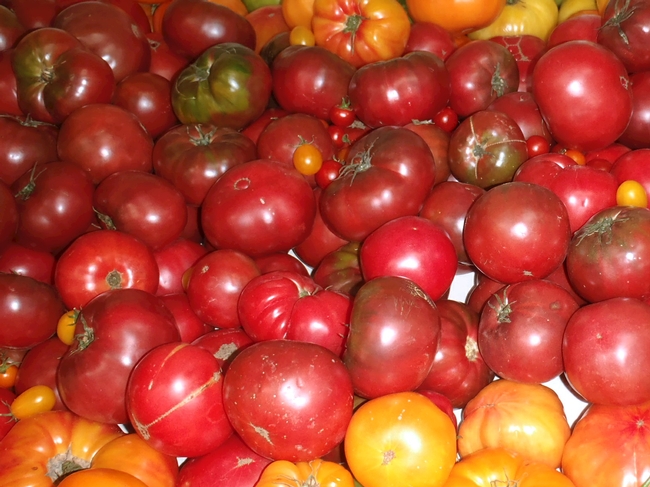
Tomatoes. (photo by Betty Homer)
Plant Chewing Puppy
It is about time to make some choices for my spring vegetable garden. Tomatoes come to mind first. Last year my tomatoes did well and I have been looking forward to trying a few newcomers this year. But, as I now have a puppy in the house, I thought “are tomatoes toxic to my new pup, Marco ?”. This little guy hasn’t met a plant that he doesn’t want to chew. Soon after he entered our home, he made it clear that I needed to be aware of the hazards living in the backyard. He would come in from a romp in the yard with a mouthful of flower petals or twigs he pulled from a tree or bush.
I talked to my vet about Marco and his attraction to plants. He handed over a stack of literature. Among them was a pamphlet published by the ASPCA with lists of foods and plants that can be harmful to our pets. This pamphlet was the beginning of my quest for more information on toxic plants. I found a number of websites including www.petpoisonhelpline.com and www.ASPCA.org/pet-care/poison-control that were very informative and helpful as I inventoried the plants in my backyard, then researched each one for toxicity information. These sites also provided details on the mechanisms of toxicity. You would think that I would have known better. But no, I was shocked to find that a good number of plants in my yard were indeed toxic to my new housemate.Well, I now have some happy neighbors with many plants in the Liliaceae family, my Hydrangeas, many Euphorbias, and Nandina domestica ‘Compacta’now planted in their yards. I expect as Marco grows out of his puppy-hood, he will be less attracted to the plants for chew toys. But who knows, and in the meantime I have peace of mind that he won’t get sick from these plants. Even though, these websites and reference manuals have multiple tables and lists galore, of toxic plants. There are so many plants coming into the nurseries . At this point if I can’t find information on a plant, I assume it could be toxic and won’t purchase it.
So now, back to the tomatoes and other vegetable potentials for my spring garden. This time I started with the handbook provided during my Master Gardener training back in 2009, The California Master Gardener Handbook, a University of California, Agriculture and Natural Resource publication. And yep, right there on page 643 is a table of Vegetables that Contain Natural Toxins. And yes, tomatoes are on the toxic list. In the case of Solanum lycopersicum, aka tomatoes, The toxic parts of the tomato are the leaves, stems and green tomatoes . So know I go to the www.petpoisonhelpline.com to get the scoop on tomatoes. This site provides the following: The tomato is poisonous to cats, dogs and cows. Common signs to watch for are vomiting, diarrhea, lethargy, weakness and confusion. The ripened fruit of the tomato plant is considered non-toxic but the green parts of the plant contain solanine, a glycoalkoloid. Solanine is also found in many other plants in the Solanaceae family including the potato plant (green parts only). Typically, when ingested by dogs and cats it rarely results in toxicity. A large amount needs to be ingested (e.g.typically in cattle) for solanine to result in severe poisoning. . As I read it, the plants probably won’t kill my pup, just make him sick. So for this spring I think I will skip the tomatoes and go to Larry Produce for my annual tomato canning frenzy.
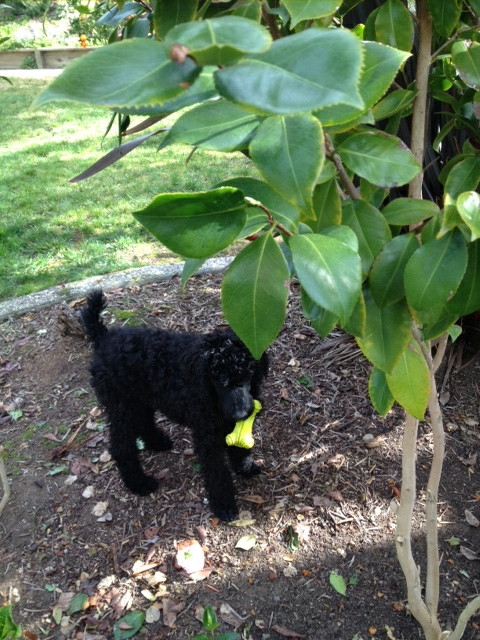
Marco, plant-eating puppy. photo by Trisha Rose
How NOT to Grow Giant Sunflowers
A few years ago, we grew a mammoth sunflower that my son has talked about ever since. We had planted it in our raised vegetable bed so it had good sun, good soil, and a good water supply. Unfortunately, it wasn’t so good for the vegetables that struggled to compete with it!
We have tried to grow giant sunflowers every year since in other areas of the yard that didn’t require sacrificing a zucchini plant or a tomato crop. But perhaps due to the clay soil, more sporadic irrigation, or hungry birds or squirrels, we couldn’t even get the seeds to germinate.
So this year, I gave up a corner of my raised vegetable bed to growing a giant sunflower again for my son. The seeds germinated quickly and the seedlings happily grew . . . and then we went on vacation. When we returned, the seedlings were so big that I was reluctant to thin them for fear of disturbing the roots of their siblings. (That, and I’m a bit too soft-hearted to thin seedlings like I know I should.) Giant sunflowers should be space 20-24” apart. If they are planted too closely, the seed head will be smaller.
Ultimately, instead of a giant sunflower, we have ended up with a crop of 5 very tall sunflowers with good-sized—but definitely not giant—seed heads. Being contrary flowers, they prefer to face our sunnier neighbor’s yard than our own. We didn’t get the mammoth sunflower that we were hoping for, but I have to admit, the cheery faces of the sunflowers that we do have more than make up for it. Plus, I know my finches will be happy when the seeds ripen! It was definitely worth worth skipping a few zucchini this year.
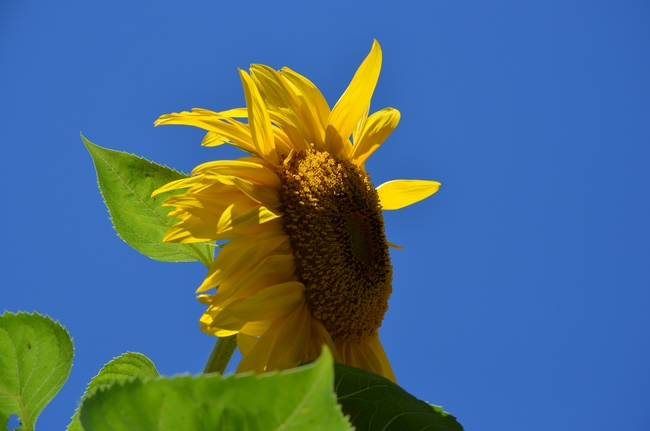
Giant sunflower. (photo by Erin Mahaney)
A Small Vegetable Garden-At Last!
Now that I have a small patch of sun, since having cut my avocado tree cut down. The tree was always growing towards my neighbors roof. I decided to see if I could grow a few vegetables in this sunny, newly reclaimed area.
The soil was dug, compost added in hopes that this might encourage the vegetables to grow. I had a cherry tomato planted in a container that I now have sitting in the garden. Two 'San Marzano' tomato plants were planted, and maybe I will get enough to make spaghetti sauce from them. Also a small eggplant with the name of 'Bambino', a sweet Italian pepper, an orange bell pepper, basil ,oregano, and parsley are also growing in this small garden.
Because I have mainly shade in my yard, this patch of sun for gardening is exciting and hopeful for me. Maybe one day when asked if I grow any vegetables I will be able to say "yes".
The sculptor face was made by my daughter she is to watch over the garden and encourage them to grow.
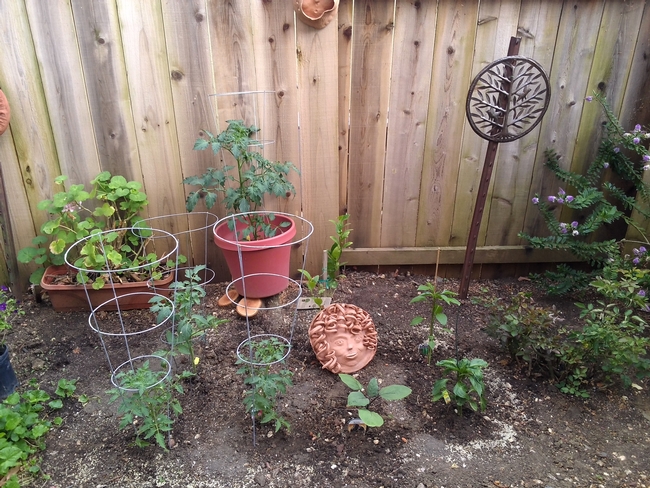
The new vegetable garden. (photo by Toni Greer)

